Unit 10 I'd like some noodles.单元复习课件(词组+句型+知识点+语法+写作指导+易错考点)
文档属性
| 名称 | Unit 10 I'd like some noodles.单元复习课件(词组+句型+知识点+语法+写作指导+易错考点) | 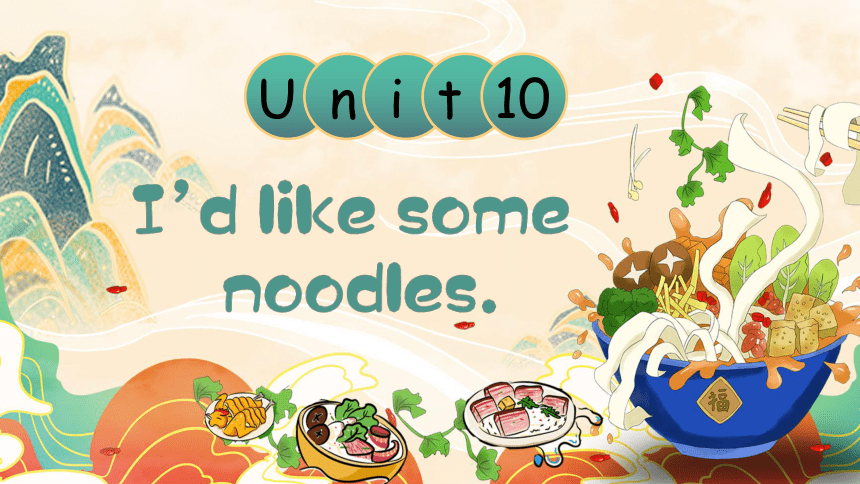 | |
| 格式 | pptx | ||
| 文件大小 | 50.9MB | ||
| 资源类型 | 试卷 | ||
| 版本资源 | 人教新目标(Go for it)版 | ||
| 科目 | 英语 | ||
| 更新时间 | 2024-05-27 15:49:58 | ||
图片预览

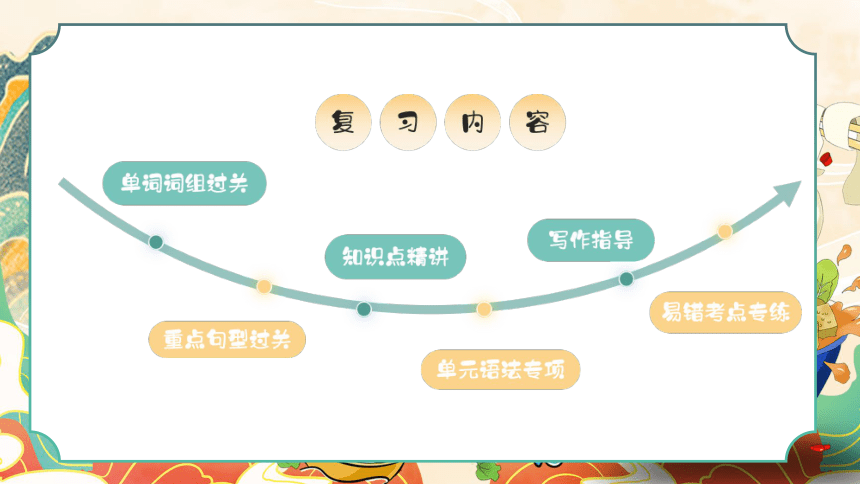

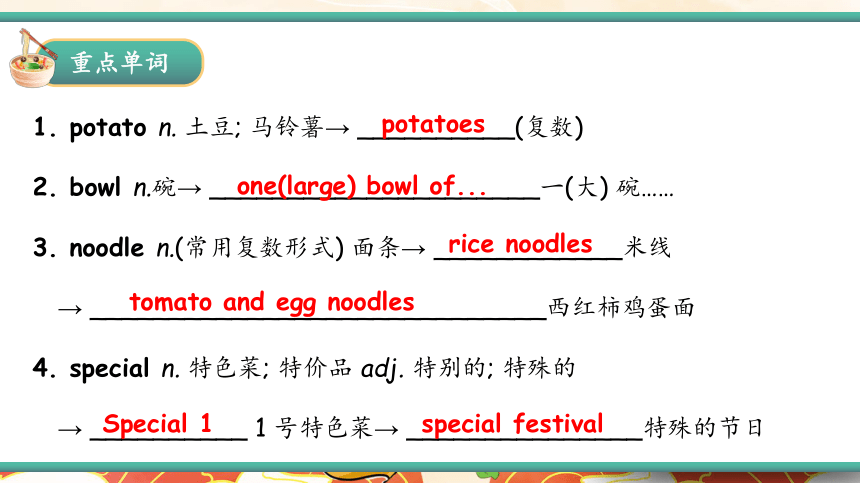
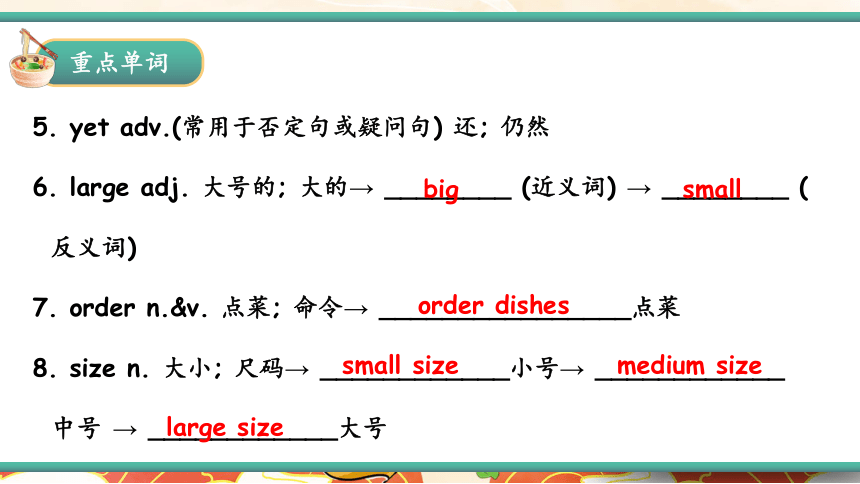

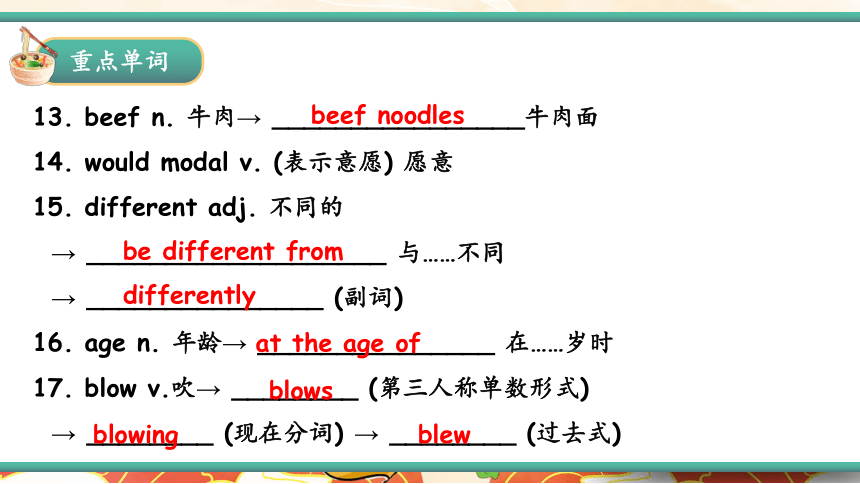
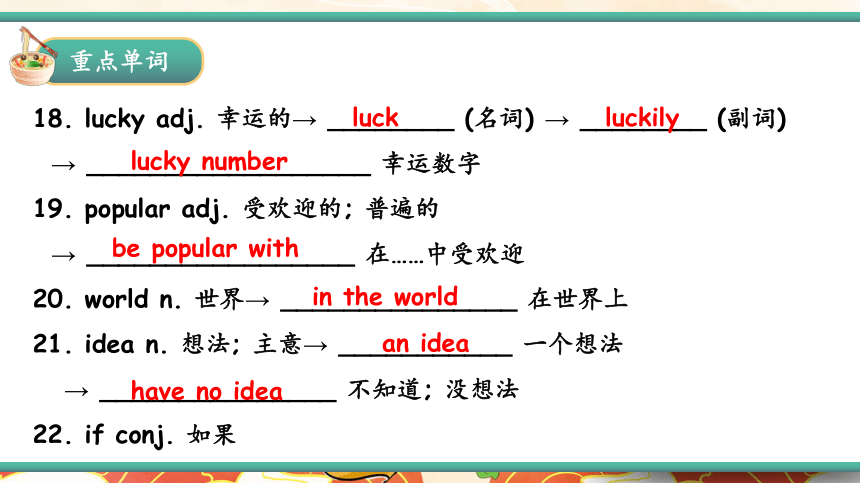
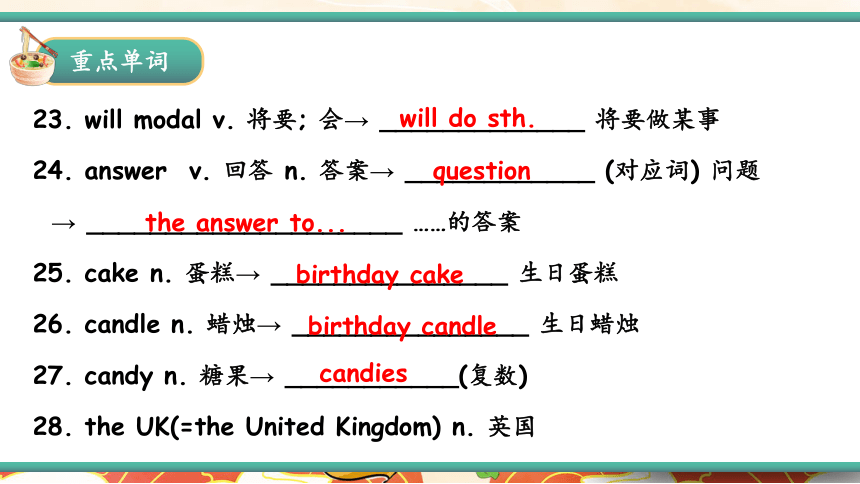
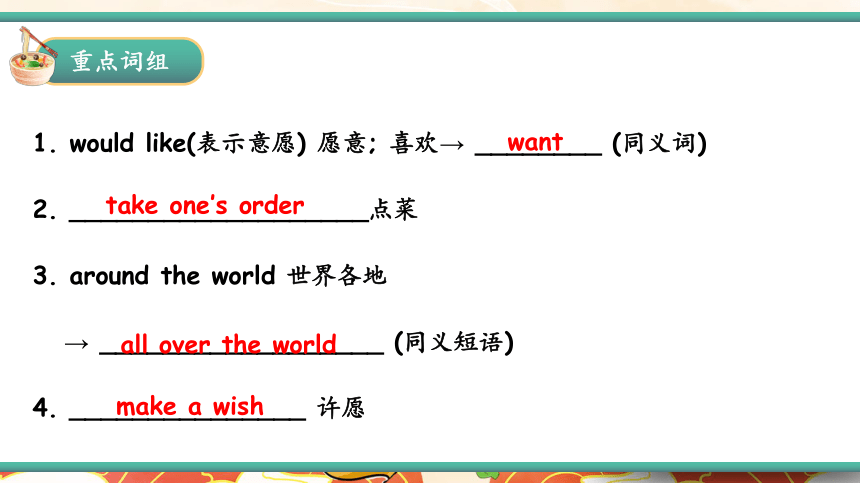
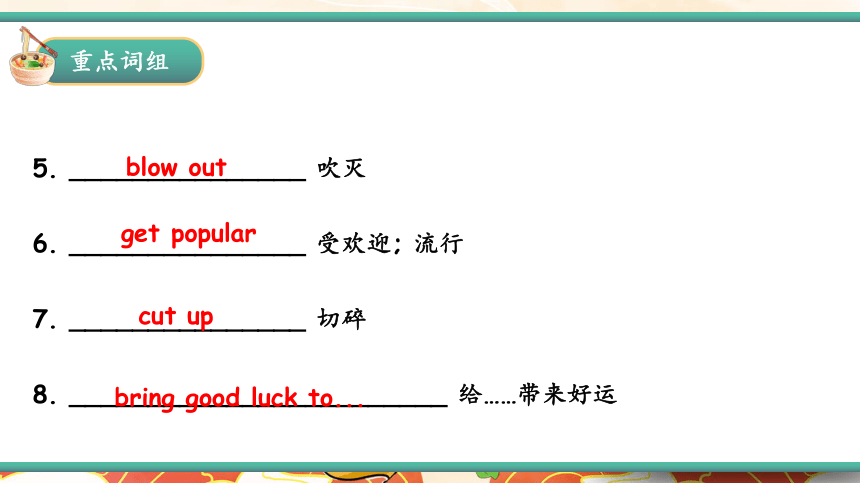

文档简介
(共144张PPT)
U n i t 10
中华
美食
重点单词
1. potato n. 土豆; 马铃薯→ __________(复数)
2. bowl n.碗→ _____________________一(大) 碗……
3. noodle n.(常用复数形式) 面条→ ____________米线
→ _____________________________西红柿鸡蛋面
4. special n. 特色菜; 特价品 adj. 特别的; 特殊的
→ __________ 1 号特色菜→ _______________特殊的节日
potatoes
one(large) bowl of...
rice noodles
tomato and egg noodles
Special 1
special festival
5. yet adv.(常用于否定句或疑问句) 还; 仍然
6. large adj. 大号的; 大的→ ________ (近义词) → ________ (反义词)
7. order n.&v. 点菜; 命令→ ________________点菜
8. size n. 大小; 尺码→ ____________小号→ ____________ 中号 → ____________大号
big
small
order dishes
small size
medium size
large size
重点单词
9. meat n.(可食用的) 肉→ _________鸡肉
→ _________鱼肉 → _________猪肉
→ _________牛肉→ _________羊肉
10. fish n. 鱼; 鱼肉→ ________________(复数) 鱼
→ ______________一些鱼肉
11. dumpling n. 饺子→ _________________包饺子
12. pancake n. 烙饼; 薄饼
chicken
fish pork
beef mutton
重点单词
fishes/fish
some fish
make dumplings
13. beef n. 牛肉→ ________________牛肉面
14. would modal v. (表示意愿) 愿意
15. different adj. 不同的
→ ___________________ 与……不同
→ _______________ (副词)
16. age n. 年龄→ _______________ 在……岁时
17. blow v.吹→ ________ (第三人称单数形式)
→ ________ (现在分词) → ________ (过去式)
重点单词
beef noodles
be different from
differently
at the age of
blows
blowing blew
18. lucky adj. 幸运的→ ________ (名词) → ________ (副词)
→ __________________ 幸运数字
19. popular adj. 受欢迎的; 普遍的
→ _________________ 在……中受欢迎
20. world n. 世界→ _______________ 在世界上
21. idea n. 想法; 主意→ ___________ 一个想法
→ _______________ 不知道; 没想法
22. if conj. 如果
luck luckily
lucky number
be popular with
in the world
an idea
have no idea
重点单词
23. will modal v. 将要; 会→ _____________ 将要做某事
24. answer v. 回答 n. 答案→ ____________ (对应词) 问题
→ ____________________ ……的答案
25. cake n. 蛋糕→ _______________ 生日蛋糕
26. candle n. 蜡烛→ _______________ 生日蜡烛
27. candy n. 糖果→ ___________(复数)
28. the UK(=the United Kingdom) n. 英国
will do sth.
question
the answer to...
birthday cake
birthday candle
candies
重点单词
1. would like(表示意愿) 愿意; 喜欢→ ________ (同义词)
2. ___________________点菜
3. around the world 世界各地
→ __________________ (同义短语)
4. _______________ 许愿
重点词组
want
take one’s order
all over the world
make a wish
5. _______________ 吹灭
6. _______________ 受欢迎; 流行
7. _______________ 切碎
8. ________________________ 给……带来好运
重点词组
blow out
get popular
cut up
bring good luck to...
中华
美食
1. —________ ________ ________ ________
您想要什么
—________ ________ ________ yet. 我还不确定。
2. May I ________ ________ ________ 您可以点餐了吗
3. —________ ________ would you like 你要多大碗的
—Large, please. 请给我大碗的。
重点句型
What would you like
I’m not sure
take your order
What size
4. —_________ _________ _________ a large bowl
你想要大碗的吗
—_________, _________. 是的, 谢谢。
5. —________ ________ ________ noodles would you like
你想要哪种面条
—_________ _________ beef noodles, please.
请给我来份牛肉面。
重点句型
Would you like
Yes please
What kind of
I’d like
6. ________ ________ ________ onions, green tea or porridge. 我不喜欢洋葱、绿茶和粥。
7. _______ _______ people ________ _______ ________ on their birthday 过生日时人们想吃什么
8.But we ________ ________ ________ fish.
但是我们缺少鱼肉。
重点句型
I don’t like
What would like to eat
are short of
中华
美食
e.g. He’d like some potatoes. 他想要一些土豆。
拓展:以字母-o 结尾的名词:有生命的词,复数形式是在词尾加-es;
无生命的词,复数形式是在词尾加-s。
e.g. tomato — tomatoes 西红柿 hero — heroes 英雄
photo — photos 照片 radio — radios 收音机
知识点1:potato/p te t / n. 土豆; 马铃薯
We’re going to make vegetable salad. How many
_______________ (tomato) do we need
tomatoes
典型例题
e.g. Would you like beef or mutton
你想要牛肉还是羊肉
知识点2:beef/bi f/ n. 牛肉
考向:表示肉类的名词是不可数名词。如:
fish 鱼肉 chicken 鸡肉 mutton 羊肉 beef 牛肉
—Lisa, could you help me buy some _____ on your way home
—OK, Mom.
A. egg B. beef
C. banana D. potato
典型例题
考向:谈论尚未发生但可能发生的事。具体用法如下:
知识点3:yet /jet/ adv. (常用于否定句或疑问句) 还;仍然
用法 示例
用在否定句中, 意为“还; 仍然”。 The reason isn’t clear yet. 原因尚不清楚。
用在疑问句中, 意为“已经”。 Is everything ready yet
一切都已经准备就绪了吗?
辨析:yet、already和still
知识点3:yet /jet/ adv. (常用于否定句或疑问句) 还;仍然
yet “还;仍然”,指尚未发生但可能发生的事;
already “已经”,强调动作已经开始发生或某种情况已经存在;
still “还,仍然”,强调原有状态没有改变。
一语辨异:
It's already 6:00 p.m. Jack isn't back yet. He is still at school.
已经是下午6点了。杰克还没回来,他还在学校。
拓展: yet 还可用作连词,用于肯定句中,意为“然而;但是”。
e.g. He has a good job. It is strange yet true.
他有份好工作。这虽然奇怪却是真实的。
知识点3:yet /jet/ adv. (常用于否定句或疑问句) 还;仍然
—What food would you like to eat
—Oh, I’m not sure _______.
A. yet B. too
C. also D. only
典型例题
e.g. What are the specials in your restaurant
你们餐厅有什么特色菜?
知识点4:special/spe l/ n. 特色菜; 特价品
special 作形容词时的常见搭配:
① a special day 一个特别的日子
② a special train 专列
③ special education 特殊教育
拓展:(1) special 还可作形容词, 意为“特别的, 特殊的; 专用的”。
e.g. Is there anything special in our school
我们学校有什么特别的地方吗?
You can go to a special hospital. 你可以去专科医院。
(2) special 的副词形式是specially, 意为“特别; 特意; 专门地”。
e.g. We come specially to learn from you.
我们是特地来向您学习的。
知识点4:special/spe l/ n. 特色菜; 特价品
There is no other food that is as s as nang in
Xinjiang.
典型例题
【点拨】由no other food与nang 及首字母s 可知,句意应为“在新疆,没有其他的食物和馕一样特殊”。
pecial
考向:May I take your order 您可以点餐了吗?
本句是点餐常用语, 用于服务员询问客人是否可以点餐了。
回答时一般先说 “Yes.”,然后说“I’d like...” 说明点什么餐。
e.g. —May I take your order 您现在点餐吗?
—Yes. I’d like one bowl of mutton noodles.
是的。我想要一碗羊肉面。
知识点5:May I take your order 您可以点餐了吗?
其他点餐的常用语:
Are you ready to order 您可以点餐了吗?
What would you like 你想吃/喝些什么?
Can I help you
= What can I do for you 您想要点什么?
Here’s the menu. 给您菜单。
—________
—Yes. I’d like a bowl of beef noodles.
A. Can you help me B. How was your day
C. May I take your order D. What would you like to drink
典型例题
【点拨】用情景交际法。由答语可知,问句应是一般疑问句且与点餐有关,故用May I take your order。
考向①:作名词,意为“点菜”,take one’s order “点菜”。
e.g. This is your order. 这是你点的菜。
You can take your order online.
你可以在线点菜。
知识点6:order / (r) d (r) / n. &v. 点菜; 命令
in order to 为了
e.g. We should be honest in order to teach honesty to our children.
我们应该诚实,以便教我们的孩子诚实。
考向②:作名词, 意为“命令;顺序”, keep in good order “井然有序”。
e.g. He found everything in good order.
他发现一切井然有序。
知识点6:order / (r) d (r) / n. &v. 点菜; 命令
考向②:order 作动词时还可意为“点菜;命令; 订购”。
order sb. to do sth. 命令某人做某事。
e.g. He is ordering his son to do homework.
他在命令儿子去做作业。
I’d like to order some noodles. 我想点些面条。
I want to order a book on the Internet.
我想在网上订购一本书。
知识点6:order / (r) d (r) / n. &v. 点菜; 命令
Kate’s room is in good o and everything is in its
proper place.
典型例题
rder
考向:one bowl of...= a bowl of 后跟可数名词复数或不可数名词, 强调容量而不是数量;表示复数概念时, 直接把bowl 变为复数形式即可。
e.g. Mary only eats one bowl of porridge for breakfast.
玛丽早餐只吃一碗粥。
There are two bowls of rice on the table.
桌子上有两碗米饭。
知识点7:one bowl of... 一碗
不可数名词数量的表达:
“不定冠词/基数词+量词+ of +不可数名词”结构常用来表示不可数名词的数量。
e.g. a bottle of water 一瓶水
two bags of rice 两袋大米
a glass of milk 一杯牛奶
拓展:“基数词+ 量词+ of + 名词”作主语时,谓语动词与量词在数上保持一致。
e.g. A box of books is OK. 一箱子书就可以了。
There are two bags of rice.
有两袋米。
知识点7:one bowl of... 一碗
考向:What size... ……多大尺寸/ 尺码?
此句型是用来询问物体的大小、尺寸的句型, 其中size 用作名词, 意为“大小;尺码”。
知识点8:What size... …… 多大尺寸/ 尺码?
在表达大、中、小号时常用以下词:
L=large 大号的 M=medium 中号的
S=small 小号的
e.g. —What size shoes does your father wear
你爸爸穿多大号的鞋?
—He wears size 41. 他穿41 号的鞋。
—What size bowl of rice would you like
你想要多大碗的米饭?
—A large bowl, please. 请来一大碗。
知识点8:What size... …… 多大尺寸/ 尺码?
考向①:作“鱼肉”讲时, 是不可数名词。
e.g. I had fish for dinner. 晚餐我吃了鱼肉。
考向②:作“鱼”讲时, 是可数名词, 复数有两种, 如果表示数量上
的复数为 fish; 如果表示种类上的复数为fishes。
They caught several fish. 他们捉了几条鱼。
There are many fishes in the sea. 大海里有很多种鱼。
知识点9:fish/f / n. 鱼; 鱼肉
拓展: fish 还可用作动词, 意为“捕鱼; 钓鱼”。
e.g. He likes to fish on the weekend.
他喜欢在周末钓鱼。
知识点9:fish/f / n. 鱼; 鱼肉
考向:or 在此处是并列连词, 用于否定句中, 在肯定句中用and。
e.g. I don’t like chicken or beef. 我不喜欢鸡肉和牛肉。
I like apples, pears and milk. 我喜欢苹果、梨和牛奶。
知识点10:or / (r)/ conj. 或; 或者
特别提醒: 当句中有两个并列成分时, and/or 放在这两个成分中间;当句中有三个或三个以上并列成分时, and/or 只用在最后两个成分之间, 前面的用逗号隔开。
拓展:在否定句中, 如果连接的两个词前都有否定词时,则一般用and,而不用or 连接, 即no A and no B = no A or B。
e.g. That woman has no phone and no computer.
= That woman has no phone or computer.
= That woman doesn’t have phones or computers.
那个女人没有手机,也没有电脑。
知识点10:or / (r)/ conj. 或; 或者
—Mary doesn’t like fish ______ chicken.
—Ben doesn’t like fish, ______ he likes chicken very much.
A. and; but B. or; but
C. or; and D. and; or
典型例题
【点拨】第一空表示并列关系,且用于否定句中,用“or”。第二空表示转折关系,用“but”。
e.g. We have friends around the world.
我们有世界各地的朋友。
Which is the largest city in the world
世界上最大的城市是哪个?
知识点11:around the world 世界各地
相当于all over the world
在世界上
易错点:
world 像sun(太阳) 和 moon(月亮) 一样,为独一无二的事物,其前通常要加定冠词
the。
Hong Kong is in the south of China; it’s one of the busiest
cities _______ the world.
A. in B. on
C. at D. to
典型例题
e.g. Your answers are all right. 你的答案都对。
I don’t know the answer to this question.
我不知道这个问题的答案。
Can you answer this question 你能回答这个问题吗?
Please answer the telephone. 请接电话。
知识点12: answer /'ɑ ns / n. 答案 v. 回答
……的答案
answer 的一词多义:
可数名词,“答案;答复”
及物动词,“回答;接(电话)”
不及物动词,“回答”
Just at that moment, the telephone rang. She had to
________ it.
A. send B. buy
C. answer D. voice
典型例题
考向: different 反义词为same,意为“相同的”。Be different from“与……不同”,反义短语是be the same as“与……相同”。
different 的词形变换:
differently adv. 不同地
difference n. 不同;差异
知识点13:different /'d f r nt/ adj. 不同的
e.g. We each have different ideas.我们每个人都有不同的想法。
My eating habits are different from (= are not the same as)
yours. 我的饮食习惯与你的不同。
He does things differently. 他做事很不同。
There are many differences between Chinese culture and
Western culture. 中国文化和西方文化之间有很多不同。
知识点13:different /'d f r nt/ adj. 不同的
Many teenagers don’t like to talk with their parents. But I am
_______ them. I love to share my joy and sorrow(悲伤)
with my parents.
A. the same as B. different from
C. interested in D. angry with
典型例题
辨析: the number of与 a number of
知识点13:the number of. . . ……的数量
The number of……的数量 后跟可数名词复数作主语时,谓语动词用单数形式。 The number of the students in our class is 50. 我们班的学生人数是50。
a number of 许多…… 后跟可数名词复数作主语时,谓语动词用复数形式。 A number of students are
playing basketball.
许多学生正在打篮球。
温馨提示:
a number of 中还可以加形容词
large, small 等表示数量多或少。
a large/small number of
大量/少数
In our school library, there _______ a number of books on art.
The number of the books _______ still growing larger and
larger.
A. is; is B. are; is
C. is; are D. are; are
典型例题
考向:age 常用于短语at the age of = at age... = at +基数词,意为“在……岁时”,可转换为when 引导的时间状语从句。
e.g. She could play the piano at the age of 4.
= She could play the piano when she was 4 years old.
她在4岁时就会弹钢琴了。
知识点14:age /e d / n. 年龄
拓展:
(1) 询问年龄时,常用“How old is/ are sb. ”或 “What’s sb.’s age ”。
e.g. What’s your age = How old are you 你多大了?
(2) at one’s age 意为“在某人这个年纪”。
e.g. At her age she should know that it’s wrong.
在她这个年纪她应该知道那是不对的。
知识点14:age /e d / n. 年龄
考向:wish作名词,意为“愿望”
e.g. I want to make a wish tonight.
今晚我想许个愿。
My wish is to become a doctor.
我的愿望是成为一名医生。
知识点15:make a wish 许愿
拓展:make 作使役动词时,意为“使得”,后接不带to的不定式或形容词等作宾语补足语;作行为动词时,意为“制造;做”,后接名词,强调做的东西。
e.g. The mother makes her little son make a model plane.
这位妈妈让她的小儿子做了个飞机模型。
知识点15:make a wish 许愿
考向:blow out 是“动词+ 副词”的结构。代词作宾语时,要置于blow 和out 中间。
e.g. A strong wind blew out our fire ( = blow our fire out).
一阵大风吹灭了我们的火。
Look at the lighted matches! Let’s blow them out.
看那些燃着的火柴!咱们把它们吹灭吧。
知识点16:blow out 吹灭
拓展:blow 作不及物动词,意为“吹;刮”。
e.g. The wind is blowing outside. 外面在刮风。
知识点16:blow out 吹灭
速记小法:巧记动副短语及代词位置
动副短语要留心,名词前后均可放,代词只能放中心。
一语辨异:
The wind is blowing.
It is blowing a fire out.
风在刮,它正吹灭一堆火。
He lights a candle, but soon the wind _______.
A. blows out it B. blows it out
C. calls up it D. calls it up
典型例题
考向:含有if 引导的条件状语从句的复合句,主句用一般将来时,从句用一般现在时表示将来,即“主将从现”。if 作连词,意为“如果”。if 从句放在句首时,从句后常加逗号,与主句隔开。
e.g. If it rains tomorrow, we’ll stay at home.
如果明天下雨, 我们将待在家里。
If you keep working hard, you will succeed some day.
如果你继续努力,总有一天你会成功的。
知识点17:if 引导的条件状语从句
拓展:if 作连词还可用于引导宾语从句,意为“是否”。
e.g. I want to know if it will rain tomorrow.
我想知道明天是否下雨。
知识点17:if 引导的条件状语从句
巧记if 条件句
if 条件句不一般, 几个要点记心间:
条件句, 放在前, 逗号要放句中间;
条件句, 表可能, 主句多用将来时。
If this _________(go) on, the wild animals will soon have
nowhere to live.
典型例题
【点拨】if 引导的条件状语从句遵循“主将从现”原则,从句用一般现在时,主语是this,动词用单三形式。
goes
get 用系动词时的常用短语:
① get lost 迷路 ② get tired 疲惫
③ get dressed 穿好衣服
e.g. We get wiser as we grow up.
随着我们的成长, 我们变得更明智了。
知识点18:get /ɡet/ v. 变得
辨析: get, become, turn与grow
如此多“变” get: 指人的感情、身体状况、自然或社会发生变化, 后多接比较级。
become: 指身份、职位的变化; 用作瞬间动词时, 指状态的变化, 强调变化的结果。
turn: 指颜色和性质方面变得与原来不同。
grow: 着重变化过程, 表示“逐渐变成”, 多指生长性变化。
e.g. The weather gets colder, and the day gets shorter.
天气变得更冷了,白天变得更短了。
He became an artist. 他成为了一名艺术家。
His face turned red. 他的脸变红了。
As time went on, he grew more and more impatient.
随着时间的流逝,他变得越来越没有耐心了。
知识点18:get /ɡet/ v. 变得
拓展:get 的其他用法:
及物动词,“得到” e.g. get the answer to the question 得到问题的答案
及物动词,“去取” e.g. get the book for him 给他把书取来
不及物动词,“到达” e.g. get to sp. 到达某地
由于环境保护,山越来越绿了。
Thanks to environmental protection, the mountains are
____________________________ greener and greener.
典型例题
getting/ becoming/turning
考向:popular 既可作表语也可作定语。
e.g. This kind of sweater is very popular.这种毛衣非常流行。
She is a popular teacher in our school.
她是我们学校一位受欢迎的老师。
Popular songs are popular with young people.
流行歌受年轻人的欢迎。
知识点19:popular /p pj l / adj. 受欢迎的; 普遍的
作表语
作定语
popular 的常用搭配:
① get popular
变得受欢迎、流行
② be popular with/among
受……欢迎
Hanfu, a kind of ancient Chinese clothes, is getting more and
more p among Chinese young people now.
典型例题
opular
考向:cut up 是“动词+ 副词”结构短语,名词作宾语,放在中间或后面均可。代词作宾语,放在cup 与up 之间。
e.g. —Why do you cut the apple up (cut up the apple)
你为什么把苹果切碎了?
—I cut it up because I want to make apple salad.
我切碎它是因为我想做苹果沙拉。
知识点20:cut up 切碎
与cut 相关的短语
① cut down 砍倒;削减
② cut off 切掉
③ cut out 裁剪;删去
④ cut in 插嘴
—Tina, I want to make some soup. Can you ________ some
tomatoes for me
—Sure, no problem.
A. make up B. fix up
C. put up D. cut up
典型例题
考向:可数名词,idea 以元音音素开头,用an 修饰。
e.g. I have a good idea. 我有一个好主意。
I have an idea that we can have a party for her.
我有一个想法,我们可以为她举办一个聚会。
知识点21:idea /a d / n. 想法; 主意
拓展:(1)当别人提出一个好的建议和想法时, 我们通常用That’s a good idea! 或Good idea! 来表示同意。
e.g. —Let’s go out for a walk. 让我们出去散散步吧。
—That’s a good idea! 那是个好主意!
(2)I have no idea.“我不知道”。相当于“I don’t know.”。
e.g. Mary has no idea(doesn’t know)how to learn Chinese well.
玛丽不知该如何学好汉语。
知识点21:idea /a d / n. 想法; 主意
She had a good _______ when she saw the apple tree in the
yard. She decided to draw a picture of the tree each day.
A. job B. idea
C. life D. trip
典型例题
【点拨】用句意理解法。由后句“她决定每天画一张这棵树的图片。”可知,当她看到院子里的苹果树时有了一个想法。
中华
美食
would like 的用法
概述 would like 意为“想要; 愿意”,相当于want,但语气更加委婉,表示要求、希望或询问等。would like 可缩写为 ’d like。在一般疑问句中把would 提到主语前,否定句中在would 后加not。
构成 would like sth. 想要某物
would like to do sth. 想要做某事
would like sb. to do sth. 想要某人做某事
基本 句式 Would you like sth. “你想要某物吗?”,表示征求意见。
肯定回答:Yes, please. / 否定回答:No, thanks.
Would you like to do sth. “你想做某事吗?”,表示征求意见。
肯定回答:Yes, I’d like/love to. /That sounds like fun.
否定回答:Sorry, I’m afraid not./I’d love to, but...
What would you like (to do) “你想要(做)什么?”,表示询问对方的意愿。回答:I’d like (to)...
用法 would like 构成的问句常表示委婉语气或希望得到对方的肯定回答,故问句中的some 不用变为any。
考点1:would like sth. 想要某物
e.g. Li Ming would like a new phone.
李明想要一部新手机。
典型例题: They want to take a rest after a two-hour drive .
(改为同义句)
They _________ _________ to take a rest after a
two-hour drive.
would like
考点2:would like to do sth. 想要做某事
e.g. We all would like to visit the museum on the weekend.
我们都想在周末去参观博物馆。
典型例题:
Tom would like to c a meal for his mother on her
birthday.
ook
考点3:would like sb. to do sth. 想要某人做某事
e.g. My mother would like me to go to college.
我妈妈想让我上大学。
考点4:would like 基本句式①
句型结构:
问句:Would you like sth. “你想要某物吗?”,表示征求意见。
肯定回答:Yes, please. / 否定回答:No, thanks.
e.g. —Would you like some tea 你想要一些茶吗?
—Yes, please./No, thanks.
好的,谢谢。/ 不用了,谢谢。
考点5:would like 基本句式②
句型结构:
问句:Would you like to do sth. “你想做某事吗?”,表示征求意见。
肯定回答:Yes, I’d like/love to. /That sounds like fun.
否定回答:Sorry, I’m afraid not./I’d love to, but...
e.g. —Would you like to go swimming with me
你想和我一起去游泳吗?
—I’d love to, but I’m very busy. 我很想去,但我很忙。
—Would you like to have a picnic with us
—_________. Thanks.
A. Yes, I’d love to
B. It doesn’t matter
C. I’m sorry to hear that
D. I don’t think so
典型例题
—Would you like to play basketball with us tomorrow
—______, but these days I’m too busy with the singing competition.
A. I’ll take your suggestion B. I’m sorry to hear that
C. That sounds like fun D. With pleasure
典型例题
【点拨】用情景交际法。上句Would you like to do sth. 有礼貌地向别人提出邀请或建议,由下句中“但这些天我忙于歌唱比赛”可推知空处是先作出了一个礼貌性的回答。
考点6:would like 基本句式③
句型结构:
--What would you like (to do) “你想要(做)什么?”,表示询问对方的意愿。
--I’d like (to)...
e.g. —What would you like to do 你想做什么?
—I’d like to visit Hong Kong-Zhuhai-Macao Bridge.
我想参观港珠澳大桥。
—Would you like some eggs
—________ I’d like some chicken.
A. No, thanks. B. Yes, please.
C. I really like eggs. D. That’s right.
典型例题
考点6:would like 的用法
用法:would like 构成的问句常表示委婉语气或希望得到对方的肯定回答,故问句中的some 不用变为any。
e.g. Would you like some bananas
你想要些香蕉吗?
—There is no salt left. Jim, would you like to get _______
—OK, Mum.
A. it B. one C. some D. any
典型例题
【点拨】Would you like... 表示委婉的请求,希望得到对方的肯定回答,问句中常用some,不用any。
名词的数
可数 名词 特点 可以直接用数目进行计算;有单复数之分,单数可用a/an 修饰,复数可用some,many,lots of 等修饰。①
可数名词 变复数的 规则变化 一般在词尾加-s。 如:car-cars book-books
以s,x,ch,sh 结尾的可数名词,在词尾加-es。
如:bus-buses box-boxes watch-watches dish-dishes
以“辅音字母+y”结尾的名词,变y 为i 再加-es。
如:dictionary-dictionaries family-families
以f 或fe 结尾的可数名词,变f 或fe 为v,再加-es。
如:knife-knives leaf-leaves
以o 结尾的可数名词,无生命的加-s,有生命的加-es。
如:photo-photos radio-radios zoo-zoos
tomato-tomatoes potato-potatoes hero-heroes
可数名词 特殊形式 单复数同形。②
词形发生变化。③
不可数 名词 特点 不能直接用数目进行计算;无单复数之分,不能用a/an 修饰,可以用some,lots of,much 等修饰。④
用法 作主语时谓语动词用单数。⑤
计量不可数名词时常用“不定冠词或基数词+ 量词+of + 不可数名词”结构。⑥
In today’s DIY class, students made cards in different
____________(形状).
典型例题
【点拨】shape 此处为可数名词,根据形容词 different 可知,此处要用复数形式。
shapes
I saw some _______ and _______ dancing in the street the
day before yesterday.
A. Germen; Englishmen
B. Germans; Englishmans
C. Germans; Englishmen
典型例题
He enjoys learning about different ___________ (country)
in the world.
典型例题
【点拨】根据different 可知,此空应填复数名词。
countries
There are so many __________ (wolf) in the forest.
典型例题
【点拨】根据“many”和所给词可知,考查名词的不规则复数变化,wolf 的复数为wolves。
wolves
We help the farmers near our school to pick____________
(西红柿) every year.
____________ (child) should accept gifts from their elders
with both hands.
典型例题
tomatoes
Children
—Are you thirsty
—Yes, please give us _______.
A. three bottle water
B. three bottle of water
C. three bottles of water
D. three bottles of waters
典型例题
名词单数变复数口诀
名词单数变复数, 多数直接加-s。
词尾若是s,x,sh,ch,直接加上-es。
词尾若是f 或fe,先变f 或fe 为v,再加-es。
若见“辅音字母+y”, 把y 变i 再加-es。
词尾字母若是o, 变复数时有两种,
无生命的加-s, 有生命的加-es。
名词单数变复数口诀
oo 常要变ee, foot feet 是一例;
男人女人a 变e, man men/woman women又一例。
child 复数children, 特殊变化特殊记。
中国人(Chinese)、日本人(Japanese)还有绵羊(sheep)、鹿(deer)和金鱼(goldfish), 单数复数均自己。
中华
美食
假如你是“欣欣饺子馆”(Xinxin Dumpling House) 的老板, 请根据所给信息为你的饺子馆写一则英文广告。90 词左右。
1. 饺子品种齐全, 个大味美;
2. 现推出两种特价饺子: 鸡蛋蔬菜饺子每10 个3 元;
牛肉洋葱饺子每10 个5 元;
3. 欢迎顾客光临本店或电话订购。地址: 欣欣路20 号。
电话: 386-9388。
单 元 话 题
1. 体裁是应用文,要求写一则广告;
2. 注意时态和主谓一致;
3. 注意可数名词复数的变化;
4. 要掌握好表达方式,恰当运用关联词。
审题指导
“总分总法”介绍餐馆
第一步:引入话题。用一句话进行概括,总领全文。
第二步:详细介绍餐馆的经营内容及特色。
第三步:用一句话总结全文,欢迎大家光临,强力推出自己的餐馆。
写作方法
写作模板
﹃总分 总法﹄ 介绍餐馆 引入话题 Would you like to eat delicious dumplings 具体介绍 总体 介绍 At. . . , we have all kinds of dumplings and they are. . .
特色 介绍 Now we have two great specials!
Special 1 . . . Special 2. . .
总结全文 I think. . . Welcome to. . . ! You can also order. . . The address is. . . Our telephone number is. . . 经典词句
单词 restaurant, delicious, specials, vegetables, order, address, telephone, popular, small, medium, large, with, tomato, beef, chicken, potato, cabbage, taste, nice, friendly, lucky, size, different, idea
短语 at our restaurant, all kinds of, great specials, on the phone, be popular with, cut up, get popular, in the size of, the same as, be different from
经典词句
句子 ① Would you like to eat delicious dumplings
② At our restaurant, we have all kinds of dumplings and they are all large and delicious.
③ Now we have two great specials!
④ Welcome to our restaurant.
⑤ You can also order our delicious dumplings on the phone!
Xinxin Dumpling House
Would you like to eat delicious dumplings ①
At our restaurant, we have all kinds of dumplings and they are all large and delicious. Now we have two great specials! Special 1 has eggs and vegetables, and is just 3 yuan for 10② . Special 2 is 5 yuan for 10, and has beef and onions.
范文赏析
I think you will love our dumplings. Welcome to our restaurant! You can also order our delicious dumplings on the phone!③ The address is No. 20 Xinxin Road. Our telephone number is 386-9388.
范文赏析
本文运用了“总分总法”介绍餐馆。结构严谨、语言流畅、信息全面、叙述有条理。
第一段以一个问句总领全文, 激发人们的味蕾;
第二段对餐馆的经营内容及特色做了详细介绍;
第三段给大家享用美食的信心并介绍两种享用方式——光临本店和电话订购。
名师点评
假设你爸爸最近开了一家餐馆。请根据下面的提示写一则广告。
提示: 1.本店菜品齐全,味道鲜美,价格优惠;
2.特价面食:鸡蛋蔬菜饺子每10个5元;牛肉面条每碗7元;
3.还有许多炒菜,比如麻婆豆腐和宫保鸡丁;
4.地址:新华路116号;
5.电话:543-6688。
写作任务
餐馆广告
致欢迎词
餐馆特色
优惠活动
联系地址
联系电话
广告结束语
Welcome to our restaurant.
delicious, at very good prices, dumplings, noodles, fried dishes.
on sale
No.116 Xinhua Road
543-6688
Come and enjoy the delicious food here.
San Li Restaurant
Welcome to our restaurant. We have many different kinds of dishes. And they are all very delicious. We sell them at very good prices.
范文赏析
Would you like dumplings, noodles or fried dishes? We have dumplings with eggs and vegetables. They are just 5 yuan for 10. We have beef noodles for only 7 yuan each bowl. We also have many fried dishes on sale, such as mapo tofu and gongbao chicken.
The address is No. 116 Xinhua Road. If you want to order on the phone, you can call us at 543-e and enjoy the delicious food here.
范文赏析
假如你是烙饼店(Mr. Lee’s House of Pancakes)的店长。请根据下面的提示,写一则广告,介绍一下你的烙饼店。
写作实践
李先生的烙饼店 名称 分量 原价price 特价on sale
卷心菜胡萝卜烙饼 小份 14 yuan 13 yuan
鸡蛋烙饼 中份 16 yuan 14 yuan
洋葱牛肉烙饼 大份 18 yuan 16 yuan
Would you like some pancakes? Please come to Mr. Lee’s House of Pancakes. There are all kinds of pancakes here, small ones, medium ones and large ones. The small one is 14 yuan, the medium one is 16 yuan and the large one is 18 yuan. Now, we are at a great sale. The small pancake with cabbage and carrots is just 13 yuan. The medium pancake with eggs is just 14 yuan.
范文赏析
You can also try our large pancake with onions and beef for just 16 yuan.
Welcome to Mr. Lee’s House of Pancakes. You will like them.
范文赏析
中华
美食
order作名词时,意为“顺序”“次序”“条理”;
作名词时,也可表示“订货”“订单”“命令”;
作动词时,意为“订购”“命令”;
常用搭配:order sb. to do sth.命令某人做某事。
易错考点1:order的用法
易错考点1:order的用法
根据句意填空。
1. —May I take your order ?
—Yes. I’d like some noodles, please.
order
易错考点1:order的用法
单项选择。
2. The takeaway delivery man(外卖员)gets 10 for mutton soup.
A. jobs B. orders
C. menus D. food
易错考点1:order的用法
3. The kid learns to count(数数)in the right .
A. order B. end
C. turn D. size
易错考点1:order的用法
4. He the workers some tables for him.
A. orders; order
B. orders; to order
C. order; to order
D. order; order
易错考点2:动词+副词构成的短语
动词+副词”型短语,后接名词作宾语时,名词放在副词之前或之后都可以;
后接代词作宾语时,代词只能放在动词和副词之间。
易错考点2:动词+副词构成的短语
单项选择。
1.Can you these carrots for me? I want to make salad.
A. get up B. make up
C. put up D. cut up
易错考点2:动词+副词构成的短语
2. Look at the candles on the cake, Ann. Can you in one go?
A. blow it out B. blow out it
C. blow them out D. blow out them
易错考点2:动词+副词构成的短语
根据汉语意思完成句子。(每空一词)
3.你应该先吹灭那些蜡烛。
You should blo ut/the t/candles cadles/out
first.
blow
out/the
the/candles
candles/out
fish表示“鱼”,是可数名词,单复数同形;
表示“鱼肉”时,则为不可数名词。
② “chicken”作“鸡肉”讲时为不可数名词;
作“鸡”讲时,为可数名词。
易错考点3:fish & chicken的用法
易错考点3:fish & chicken的用法
用所给词的适当形式填空。
1. There are (be) all kinds of fish in the river.
2. I’d like to have some rice and chicken (chicken) for lunch.
are
chicken
易错考点3:fish & chicken的用法
单项选择。
3. There a lot of fish in the soup.
A. are B. is
C. have D. has
易错考点3:fish & chicken的用法
根据汉语意思完成句子。(每空一词)
4.在餐桌上你可以看到一些鱼肉。
You can see some fish on the table.
5. 我叔叔在农场养了一些鸡。
My uncle keeps some chickens on the farm.
some
fish
chickens
易错考点4:the number of 与a number of的辨析
the number of 表示“……的数量”,后面接可数名词复数作主语时,谓语动词用单数;
a number of 表示“许多”,相当于 many, 后面接可数名词复数作主语时,谓语动词用复数。
易错考点4:the number of 与a number of的辨析
单项选择。
1. students are watching the school show. them is 2,000.
A. A number of; The number of
B. A number of; A number of
C. The number of; The number of
D. The number of; A number of
易错考点4:the number of 与a number of的辨析
2. —A number of students on the bus.
—Let me count(数). The number of them 60.
A. are; is B. is; are
C. are; are D. is; is
易错考点4:the number of 与a number of的辨析
根据汉语意思完成句子。(每空一词)
3. 我们学校的老师人数是60。
The number of the teachers of our school is 60.
The
number
of
中华
美食
U n i t 10
U n i t 10
中华
美食
重点单词
1. potato n. 土豆; 马铃薯→ __________(复数)
2. bowl n.碗→ _____________________一(大) 碗……
3. noodle n.(常用复数形式) 面条→ ____________米线
→ _____________________________西红柿鸡蛋面
4. special n. 特色菜; 特价品 adj. 特别的; 特殊的
→ __________ 1 号特色菜→ _______________特殊的节日
potatoes
one(large) bowl of...
rice noodles
tomato and egg noodles
Special 1
special festival
5. yet adv.(常用于否定句或疑问句) 还; 仍然
6. large adj. 大号的; 大的→ ________ (近义词) → ________ (反义词)
7. order n.&v. 点菜; 命令→ ________________点菜
8. size n. 大小; 尺码→ ____________小号→ ____________ 中号 → ____________大号
big
small
order dishes
small size
medium size
large size
重点单词
9. meat n.(可食用的) 肉→ _________鸡肉
→ _________鱼肉 → _________猪肉
→ _________牛肉→ _________羊肉
10. fish n. 鱼; 鱼肉→ ________________(复数) 鱼
→ ______________一些鱼肉
11. dumpling n. 饺子→ _________________包饺子
12. pancake n. 烙饼; 薄饼
chicken
fish pork
beef mutton
重点单词
fishes/fish
some fish
make dumplings
13. beef n. 牛肉→ ________________牛肉面
14. would modal v. (表示意愿) 愿意
15. different adj. 不同的
→ ___________________ 与……不同
→ _______________ (副词)
16. age n. 年龄→ _______________ 在……岁时
17. blow v.吹→ ________ (第三人称单数形式)
→ ________ (现在分词) → ________ (过去式)
重点单词
beef noodles
be different from
differently
at the age of
blows
blowing blew
18. lucky adj. 幸运的→ ________ (名词) → ________ (副词)
→ __________________ 幸运数字
19. popular adj. 受欢迎的; 普遍的
→ _________________ 在……中受欢迎
20. world n. 世界→ _______________ 在世界上
21. idea n. 想法; 主意→ ___________ 一个想法
→ _______________ 不知道; 没想法
22. if conj. 如果
luck luckily
lucky number
be popular with
in the world
an idea
have no idea
重点单词
23. will modal v. 将要; 会→ _____________ 将要做某事
24. answer v. 回答 n. 答案→ ____________ (对应词) 问题
→ ____________________ ……的答案
25. cake n. 蛋糕→ _______________ 生日蛋糕
26. candle n. 蜡烛→ _______________ 生日蜡烛
27. candy n. 糖果→ ___________(复数)
28. the UK(=the United Kingdom) n. 英国
will do sth.
question
the answer to...
birthday cake
birthday candle
candies
重点单词
1. would like(表示意愿) 愿意; 喜欢→ ________ (同义词)
2. ___________________点菜
3. around the world 世界各地
→ __________________ (同义短语)
4. _______________ 许愿
重点词组
want
take one’s order
all over the world
make a wish
5. _______________ 吹灭
6. _______________ 受欢迎; 流行
7. _______________ 切碎
8. ________________________ 给……带来好运
重点词组
blow out
get popular
cut up
bring good luck to...
中华
美食
1. —________ ________ ________ ________
您想要什么
—________ ________ ________ yet. 我还不确定。
2. May I ________ ________ ________ 您可以点餐了吗
3. —________ ________ would you like 你要多大碗的
—Large, please. 请给我大碗的。
重点句型
What would you like
I’m not sure
take your order
What size
4. —_________ _________ _________ a large bowl
你想要大碗的吗
—_________, _________. 是的, 谢谢。
5. —________ ________ ________ noodles would you like
你想要哪种面条
—_________ _________ beef noodles, please.
请给我来份牛肉面。
重点句型
Would you like
Yes please
What kind of
I’d like
6. ________ ________ ________ onions, green tea or porridge. 我不喜欢洋葱、绿茶和粥。
7. _______ _______ people ________ _______ ________ on their birthday 过生日时人们想吃什么
8.But we ________ ________ ________ fish.
但是我们缺少鱼肉。
重点句型
I don’t like
What would like to eat
are short of
中华
美食
e.g. He’d like some potatoes. 他想要一些土豆。
拓展:以字母-o 结尾的名词:有生命的词,复数形式是在词尾加-es;
无生命的词,复数形式是在词尾加-s。
e.g. tomato — tomatoes 西红柿 hero — heroes 英雄
photo — photos 照片 radio — radios 收音机
知识点1:potato/p te t / n. 土豆; 马铃薯
We’re going to make vegetable salad. How many
_______________ (tomato) do we need
tomatoes
典型例题
e.g. Would you like beef or mutton
你想要牛肉还是羊肉
知识点2:beef/bi f/ n. 牛肉
考向:表示肉类的名词是不可数名词。如:
fish 鱼肉 chicken 鸡肉 mutton 羊肉 beef 牛肉
—Lisa, could you help me buy some _____ on your way home
—OK, Mom.
A. egg B. beef
C. banana D. potato
典型例题
考向:谈论尚未发生但可能发生的事。具体用法如下:
知识点3:yet /jet/ adv. (常用于否定句或疑问句) 还;仍然
用法 示例
用在否定句中, 意为“还; 仍然”。 The reason isn’t clear yet. 原因尚不清楚。
用在疑问句中, 意为“已经”。 Is everything ready yet
一切都已经准备就绪了吗?
辨析:yet、already和still
知识点3:yet /jet/ adv. (常用于否定句或疑问句) 还;仍然
yet “还;仍然”,指尚未发生但可能发生的事;
already “已经”,强调动作已经开始发生或某种情况已经存在;
still “还,仍然”,强调原有状态没有改变。
一语辨异:
It's already 6:00 p.m. Jack isn't back yet. He is still at school.
已经是下午6点了。杰克还没回来,他还在学校。
拓展: yet 还可用作连词,用于肯定句中,意为“然而;但是”。
e.g. He has a good job. It is strange yet true.
他有份好工作。这虽然奇怪却是真实的。
知识点3:yet /jet/ adv. (常用于否定句或疑问句) 还;仍然
—What food would you like to eat
—Oh, I’m not sure _______.
A. yet B. too
C. also D. only
典型例题
e.g. What are the specials in your restaurant
你们餐厅有什么特色菜?
知识点4:special/spe l/ n. 特色菜; 特价品
special 作形容词时的常见搭配:
① a special day 一个特别的日子
② a special train 专列
③ special education 特殊教育
拓展:(1) special 还可作形容词, 意为“特别的, 特殊的; 专用的”。
e.g. Is there anything special in our school
我们学校有什么特别的地方吗?
You can go to a special hospital. 你可以去专科医院。
(2) special 的副词形式是specially, 意为“特别; 特意; 专门地”。
e.g. We come specially to learn from you.
我们是特地来向您学习的。
知识点4:special/spe l/ n. 特色菜; 特价品
There is no other food that is as s as nang in
Xinjiang.
典型例题
【点拨】由no other food与nang 及首字母s 可知,句意应为“在新疆,没有其他的食物和馕一样特殊”。
pecial
考向:May I take your order 您可以点餐了吗?
本句是点餐常用语, 用于服务员询问客人是否可以点餐了。
回答时一般先说 “Yes.”,然后说“I’d like...” 说明点什么餐。
e.g. —May I take your order 您现在点餐吗?
—Yes. I’d like one bowl of mutton noodles.
是的。我想要一碗羊肉面。
知识点5:May I take your order 您可以点餐了吗?
其他点餐的常用语:
Are you ready to order 您可以点餐了吗?
What would you like 你想吃/喝些什么?
Can I help you
= What can I do for you 您想要点什么?
Here’s the menu. 给您菜单。
—________
—Yes. I’d like a bowl of beef noodles.
A. Can you help me B. How was your day
C. May I take your order D. What would you like to drink
典型例题
【点拨】用情景交际法。由答语可知,问句应是一般疑问句且与点餐有关,故用May I take your order。
考向①:作名词,意为“点菜”,take one’s order “点菜”。
e.g. This is your order. 这是你点的菜。
You can take your order online.
你可以在线点菜。
知识点6:order / (r) d (r) / n. &v. 点菜; 命令
in order to 为了
e.g. We should be honest in order to teach honesty to our children.
我们应该诚实,以便教我们的孩子诚实。
考向②:作名词, 意为“命令;顺序”, keep in good order “井然有序”。
e.g. He found everything in good order.
他发现一切井然有序。
知识点6:order / (r) d (r) / n. &v. 点菜; 命令
考向②:order 作动词时还可意为“点菜;命令; 订购”。
order sb. to do sth. 命令某人做某事。
e.g. He is ordering his son to do homework.
他在命令儿子去做作业。
I’d like to order some noodles. 我想点些面条。
I want to order a book on the Internet.
我想在网上订购一本书。
知识点6:order / (r) d (r) / n. &v. 点菜; 命令
Kate’s room is in good o and everything is in its
proper place.
典型例题
rder
考向:one bowl of...= a bowl of 后跟可数名词复数或不可数名词, 强调容量而不是数量;表示复数概念时, 直接把bowl 变为复数形式即可。
e.g. Mary only eats one bowl of porridge for breakfast.
玛丽早餐只吃一碗粥。
There are two bowls of rice on the table.
桌子上有两碗米饭。
知识点7:one bowl of... 一碗
不可数名词数量的表达:
“不定冠词/基数词+量词+ of +不可数名词”结构常用来表示不可数名词的数量。
e.g. a bottle of water 一瓶水
two bags of rice 两袋大米
a glass of milk 一杯牛奶
拓展:“基数词+ 量词+ of + 名词”作主语时,谓语动词与量词在数上保持一致。
e.g. A box of books is OK. 一箱子书就可以了。
There are two bags of rice.
有两袋米。
知识点7:one bowl of... 一碗
考向:What size... ……多大尺寸/ 尺码?
此句型是用来询问物体的大小、尺寸的句型, 其中size 用作名词, 意为“大小;尺码”。
知识点8:What size... …… 多大尺寸/ 尺码?
在表达大、中、小号时常用以下词:
L=large 大号的 M=medium 中号的
S=small 小号的
e.g. —What size shoes does your father wear
你爸爸穿多大号的鞋?
—He wears size 41. 他穿41 号的鞋。
—What size bowl of rice would you like
你想要多大碗的米饭?
—A large bowl, please. 请来一大碗。
知识点8:What size... …… 多大尺寸/ 尺码?
考向①:作“鱼肉”讲时, 是不可数名词。
e.g. I had fish for dinner. 晚餐我吃了鱼肉。
考向②:作“鱼”讲时, 是可数名词, 复数有两种, 如果表示数量上
的复数为 fish; 如果表示种类上的复数为fishes。
They caught several fish. 他们捉了几条鱼。
There are many fishes in the sea. 大海里有很多种鱼。
知识点9:fish/f / n. 鱼; 鱼肉
拓展: fish 还可用作动词, 意为“捕鱼; 钓鱼”。
e.g. He likes to fish on the weekend.
他喜欢在周末钓鱼。
知识点9:fish/f / n. 鱼; 鱼肉
考向:or 在此处是并列连词, 用于否定句中, 在肯定句中用and。
e.g. I don’t like chicken or beef. 我不喜欢鸡肉和牛肉。
I like apples, pears and milk. 我喜欢苹果、梨和牛奶。
知识点10:or / (r)/ conj. 或; 或者
特别提醒: 当句中有两个并列成分时, and/or 放在这两个成分中间;当句中有三个或三个以上并列成分时, and/or 只用在最后两个成分之间, 前面的用逗号隔开。
拓展:在否定句中, 如果连接的两个词前都有否定词时,则一般用and,而不用or 连接, 即no A and no B = no A or B。
e.g. That woman has no phone and no computer.
= That woman has no phone or computer.
= That woman doesn’t have phones or computers.
那个女人没有手机,也没有电脑。
知识点10:or / (r)/ conj. 或; 或者
—Mary doesn’t like fish ______ chicken.
—Ben doesn’t like fish, ______ he likes chicken very much.
A. and; but B. or; but
C. or; and D. and; or
典型例题
【点拨】第一空表示并列关系,且用于否定句中,用“or”。第二空表示转折关系,用“but”。
e.g. We have friends around the world.
我们有世界各地的朋友。
Which is the largest city in the world
世界上最大的城市是哪个?
知识点11:around the world 世界各地
相当于all over the world
在世界上
易错点:
world 像sun(太阳) 和 moon(月亮) 一样,为独一无二的事物,其前通常要加定冠词
the。
Hong Kong is in the south of China; it’s one of the busiest
cities _______ the world.
A. in B. on
C. at D. to
典型例题
e.g. Your answers are all right. 你的答案都对。
I don’t know the answer to this question.
我不知道这个问题的答案。
Can you answer this question 你能回答这个问题吗?
Please answer the telephone. 请接电话。
知识点12: answer /'ɑ ns / n. 答案 v. 回答
……的答案
answer 的一词多义:
可数名词,“答案;答复”
及物动词,“回答;接(电话)”
不及物动词,“回答”
Just at that moment, the telephone rang. She had to
________ it.
A. send B. buy
C. answer D. voice
典型例题
考向: different 反义词为same,意为“相同的”。Be different from“与……不同”,反义短语是be the same as“与……相同”。
different 的词形变换:
differently adv. 不同地
difference n. 不同;差异
知识点13:different /'d f r nt/ adj. 不同的
e.g. We each have different ideas.我们每个人都有不同的想法。
My eating habits are different from (= are not the same as)
yours. 我的饮食习惯与你的不同。
He does things differently. 他做事很不同。
There are many differences between Chinese culture and
Western culture. 中国文化和西方文化之间有很多不同。
知识点13:different /'d f r nt/ adj. 不同的
Many teenagers don’t like to talk with their parents. But I am
_______ them. I love to share my joy and sorrow(悲伤)
with my parents.
A. the same as B. different from
C. interested in D. angry with
典型例题
辨析: the number of与 a number of
知识点13:the number of. . . ……的数量
The number of……的数量 后跟可数名词复数作主语时,谓语动词用单数形式。 The number of the students in our class is 50. 我们班的学生人数是50。
a number of 许多…… 后跟可数名词复数作主语时,谓语动词用复数形式。 A number of students are
playing basketball.
许多学生正在打篮球。
温馨提示:
a number of 中还可以加形容词
large, small 等表示数量多或少。
a large/small number of
大量/少数
In our school library, there _______ a number of books on art.
The number of the books _______ still growing larger and
larger.
A. is; is B. are; is
C. is; are D. are; are
典型例题
考向:age 常用于短语at the age of = at age... = at +基数词,意为“在……岁时”,可转换为when 引导的时间状语从句。
e.g. She could play the piano at the age of 4.
= She could play the piano when she was 4 years old.
她在4岁时就会弹钢琴了。
知识点14:age /e d / n. 年龄
拓展:
(1) 询问年龄时,常用“How old is/ are sb. ”或 “What’s sb.’s age ”。
e.g. What’s your age = How old are you 你多大了?
(2) at one’s age 意为“在某人这个年纪”。
e.g. At her age she should know that it’s wrong.
在她这个年纪她应该知道那是不对的。
知识点14:age /e d / n. 年龄
考向:wish作名词,意为“愿望”
e.g. I want to make a wish tonight.
今晚我想许个愿。
My wish is to become a doctor.
我的愿望是成为一名医生。
知识点15:make a wish 许愿
拓展:make 作使役动词时,意为“使得”,后接不带to的不定式或形容词等作宾语补足语;作行为动词时,意为“制造;做”,后接名词,强调做的东西。
e.g. The mother makes her little son make a model plane.
这位妈妈让她的小儿子做了个飞机模型。
知识点15:make a wish 许愿
考向:blow out 是“动词+ 副词”的结构。代词作宾语时,要置于blow 和out 中间。
e.g. A strong wind blew out our fire ( = blow our fire out).
一阵大风吹灭了我们的火。
Look at the lighted matches! Let’s blow them out.
看那些燃着的火柴!咱们把它们吹灭吧。
知识点16:blow out 吹灭
拓展:blow 作不及物动词,意为“吹;刮”。
e.g. The wind is blowing outside. 外面在刮风。
知识点16:blow out 吹灭
速记小法:巧记动副短语及代词位置
动副短语要留心,名词前后均可放,代词只能放中心。
一语辨异:
The wind is blowing.
It is blowing a fire out.
风在刮,它正吹灭一堆火。
He lights a candle, but soon the wind _______.
A. blows out it B. blows it out
C. calls up it D. calls it up
典型例题
考向:含有if 引导的条件状语从句的复合句,主句用一般将来时,从句用一般现在时表示将来,即“主将从现”。if 作连词,意为“如果”。if 从句放在句首时,从句后常加逗号,与主句隔开。
e.g. If it rains tomorrow, we’ll stay at home.
如果明天下雨, 我们将待在家里。
If you keep working hard, you will succeed some day.
如果你继续努力,总有一天你会成功的。
知识点17:if 引导的条件状语从句
拓展:if 作连词还可用于引导宾语从句,意为“是否”。
e.g. I want to know if it will rain tomorrow.
我想知道明天是否下雨。
知识点17:if 引导的条件状语从句
巧记if 条件句
if 条件句不一般, 几个要点记心间:
条件句, 放在前, 逗号要放句中间;
条件句, 表可能, 主句多用将来时。
If this _________(go) on, the wild animals will soon have
nowhere to live.
典型例题
【点拨】if 引导的条件状语从句遵循“主将从现”原则,从句用一般现在时,主语是this,动词用单三形式。
goes
get 用系动词时的常用短语:
① get lost 迷路 ② get tired 疲惫
③ get dressed 穿好衣服
e.g. We get wiser as we grow up.
随着我们的成长, 我们变得更明智了。
知识点18:get /ɡet/ v. 变得
辨析: get, become, turn与grow
如此多“变” get: 指人的感情、身体状况、自然或社会发生变化, 后多接比较级。
become: 指身份、职位的变化; 用作瞬间动词时, 指状态的变化, 强调变化的结果。
turn: 指颜色和性质方面变得与原来不同。
grow: 着重变化过程, 表示“逐渐变成”, 多指生长性变化。
e.g. The weather gets colder, and the day gets shorter.
天气变得更冷了,白天变得更短了。
He became an artist. 他成为了一名艺术家。
His face turned red. 他的脸变红了。
As time went on, he grew more and more impatient.
随着时间的流逝,他变得越来越没有耐心了。
知识点18:get /ɡet/ v. 变得
拓展:get 的其他用法:
及物动词,“得到” e.g. get the answer to the question 得到问题的答案
及物动词,“去取” e.g. get the book for him 给他把书取来
不及物动词,“到达” e.g. get to sp. 到达某地
由于环境保护,山越来越绿了。
Thanks to environmental protection, the mountains are
____________________________ greener and greener.
典型例题
getting/ becoming/turning
考向:popular 既可作表语也可作定语。
e.g. This kind of sweater is very popular.这种毛衣非常流行。
She is a popular teacher in our school.
她是我们学校一位受欢迎的老师。
Popular songs are popular with young people.
流行歌受年轻人的欢迎。
知识点19:popular /p pj l / adj. 受欢迎的; 普遍的
作表语
作定语
popular 的常用搭配:
① get popular
变得受欢迎、流行
② be popular with/among
受……欢迎
Hanfu, a kind of ancient Chinese clothes, is getting more and
more p among Chinese young people now.
典型例题
opular
考向:cut up 是“动词+ 副词”结构短语,名词作宾语,放在中间或后面均可。代词作宾语,放在cup 与up 之间。
e.g. —Why do you cut the apple up (cut up the apple)
你为什么把苹果切碎了?
—I cut it up because I want to make apple salad.
我切碎它是因为我想做苹果沙拉。
知识点20:cut up 切碎
与cut 相关的短语
① cut down 砍倒;削减
② cut off 切掉
③ cut out 裁剪;删去
④ cut in 插嘴
—Tina, I want to make some soup. Can you ________ some
tomatoes for me
—Sure, no problem.
A. make up B. fix up
C. put up D. cut up
典型例题
考向:可数名词,idea 以元音音素开头,用an 修饰。
e.g. I have a good idea. 我有一个好主意。
I have an idea that we can have a party for her.
我有一个想法,我们可以为她举办一个聚会。
知识点21:idea /a d / n. 想法; 主意
拓展:(1)当别人提出一个好的建议和想法时, 我们通常用That’s a good idea! 或Good idea! 来表示同意。
e.g. —Let’s go out for a walk. 让我们出去散散步吧。
—That’s a good idea! 那是个好主意!
(2)I have no idea.“我不知道”。相当于“I don’t know.”。
e.g. Mary has no idea(doesn’t know)how to learn Chinese well.
玛丽不知该如何学好汉语。
知识点21:idea /a d / n. 想法; 主意
She had a good _______ when she saw the apple tree in the
yard. She decided to draw a picture of the tree each day.
A. job B. idea
C. life D. trip
典型例题
【点拨】用句意理解法。由后句“她决定每天画一张这棵树的图片。”可知,当她看到院子里的苹果树时有了一个想法。
中华
美食
would like 的用法
概述 would like 意为“想要; 愿意”,相当于want,但语气更加委婉,表示要求、希望或询问等。would like 可缩写为 ’d like。在一般疑问句中把would 提到主语前,否定句中在would 后加not。
构成 would like sth. 想要某物
would like to do sth. 想要做某事
would like sb. to do sth. 想要某人做某事
基本 句式 Would you like sth. “你想要某物吗?”,表示征求意见。
肯定回答:Yes, please. / 否定回答:No, thanks.
Would you like to do sth. “你想做某事吗?”,表示征求意见。
肯定回答:Yes, I’d like/love to. /That sounds like fun.
否定回答:Sorry, I’m afraid not./I’d love to, but...
What would you like (to do) “你想要(做)什么?”,表示询问对方的意愿。回答:I’d like (to)...
用法 would like 构成的问句常表示委婉语气或希望得到对方的肯定回答,故问句中的some 不用变为any。
考点1:would like sth. 想要某物
e.g. Li Ming would like a new phone.
李明想要一部新手机。
典型例题: They want to take a rest after a two-hour drive .
(改为同义句)
They _________ _________ to take a rest after a
two-hour drive.
would like
考点2:would like to do sth. 想要做某事
e.g. We all would like to visit the museum on the weekend.
我们都想在周末去参观博物馆。
典型例题:
Tom would like to c a meal for his mother on her
birthday.
ook
考点3:would like sb. to do sth. 想要某人做某事
e.g. My mother would like me to go to college.
我妈妈想让我上大学。
考点4:would like 基本句式①
句型结构:
问句:Would you like sth. “你想要某物吗?”,表示征求意见。
肯定回答:Yes, please. / 否定回答:No, thanks.
e.g. —Would you like some tea 你想要一些茶吗?
—Yes, please./No, thanks.
好的,谢谢。/ 不用了,谢谢。
考点5:would like 基本句式②
句型结构:
问句:Would you like to do sth. “你想做某事吗?”,表示征求意见。
肯定回答:Yes, I’d like/love to. /That sounds like fun.
否定回答:Sorry, I’m afraid not./I’d love to, but...
e.g. —Would you like to go swimming with me
你想和我一起去游泳吗?
—I’d love to, but I’m very busy. 我很想去,但我很忙。
—Would you like to have a picnic with us
—_________. Thanks.
A. Yes, I’d love to
B. It doesn’t matter
C. I’m sorry to hear that
D. I don’t think so
典型例题
—Would you like to play basketball with us tomorrow
—______, but these days I’m too busy with the singing competition.
A. I’ll take your suggestion B. I’m sorry to hear that
C. That sounds like fun D. With pleasure
典型例题
【点拨】用情景交际法。上句Would you like to do sth. 有礼貌地向别人提出邀请或建议,由下句中“但这些天我忙于歌唱比赛”可推知空处是先作出了一个礼貌性的回答。
考点6:would like 基本句式③
句型结构:
--What would you like (to do) “你想要(做)什么?”,表示询问对方的意愿。
--I’d like (to)...
e.g. —What would you like to do 你想做什么?
—I’d like to visit Hong Kong-Zhuhai-Macao Bridge.
我想参观港珠澳大桥。
—Would you like some eggs
—________ I’d like some chicken.
A. No, thanks. B. Yes, please.
C. I really like eggs. D. That’s right.
典型例题
考点6:would like 的用法
用法:would like 构成的问句常表示委婉语气或希望得到对方的肯定回答,故问句中的some 不用变为any。
e.g. Would you like some bananas
你想要些香蕉吗?
—There is no salt left. Jim, would you like to get _______
—OK, Mum.
A. it B. one C. some D. any
典型例题
【点拨】Would you like... 表示委婉的请求,希望得到对方的肯定回答,问句中常用some,不用any。
名词的数
可数 名词 特点 可以直接用数目进行计算;有单复数之分,单数可用a/an 修饰,复数可用some,many,lots of 等修饰。①
可数名词 变复数的 规则变化 一般在词尾加-s。 如:car-cars book-books
以s,x,ch,sh 结尾的可数名词,在词尾加-es。
如:bus-buses box-boxes watch-watches dish-dishes
以“辅音字母+y”结尾的名词,变y 为i 再加-es。
如:dictionary-dictionaries family-families
以f 或fe 结尾的可数名词,变f 或fe 为v,再加-es。
如:knife-knives leaf-leaves
以o 结尾的可数名词,无生命的加-s,有生命的加-es。
如:photo-photos radio-radios zoo-zoos
tomato-tomatoes potato-potatoes hero-heroes
可数名词 特殊形式 单复数同形。②
词形发生变化。③
不可数 名词 特点 不能直接用数目进行计算;无单复数之分,不能用a/an 修饰,可以用some,lots of,much 等修饰。④
用法 作主语时谓语动词用单数。⑤
计量不可数名词时常用“不定冠词或基数词+ 量词+of + 不可数名词”结构。⑥
In today’s DIY class, students made cards in different
____________(形状).
典型例题
【点拨】shape 此处为可数名词,根据形容词 different 可知,此处要用复数形式。
shapes
I saw some _______ and _______ dancing in the street the
day before yesterday.
A. Germen; Englishmen
B. Germans; Englishmans
C. Germans; Englishmen
典型例题
He enjoys learning about different ___________ (country)
in the world.
典型例题
【点拨】根据different 可知,此空应填复数名词。
countries
There are so many __________ (wolf) in the forest.
典型例题
【点拨】根据“many”和所给词可知,考查名词的不规则复数变化,wolf 的复数为wolves。
wolves
We help the farmers near our school to pick____________
(西红柿) every year.
____________ (child) should accept gifts from their elders
with both hands.
典型例题
tomatoes
Children
—Are you thirsty
—Yes, please give us _______.
A. three bottle water
B. three bottle of water
C. three bottles of water
D. three bottles of waters
典型例题
名词单数变复数口诀
名词单数变复数, 多数直接加-s。
词尾若是s,x,sh,ch,直接加上-es。
词尾若是f 或fe,先变f 或fe 为v,再加-es。
若见“辅音字母+y”, 把y 变i 再加-es。
词尾字母若是o, 变复数时有两种,
无生命的加-s, 有生命的加-es。
名词单数变复数口诀
oo 常要变ee, foot feet 是一例;
男人女人a 变e, man men/woman women又一例。
child 复数children, 特殊变化特殊记。
中国人(Chinese)、日本人(Japanese)还有绵羊(sheep)、鹿(deer)和金鱼(goldfish), 单数复数均自己。
中华
美食
假如你是“欣欣饺子馆”(Xinxin Dumpling House) 的老板, 请根据所给信息为你的饺子馆写一则英文广告。90 词左右。
1. 饺子品种齐全, 个大味美;
2. 现推出两种特价饺子: 鸡蛋蔬菜饺子每10 个3 元;
牛肉洋葱饺子每10 个5 元;
3. 欢迎顾客光临本店或电话订购。地址: 欣欣路20 号。
电话: 386-9388。
单 元 话 题
1. 体裁是应用文,要求写一则广告;
2. 注意时态和主谓一致;
3. 注意可数名词复数的变化;
4. 要掌握好表达方式,恰当运用关联词。
审题指导
“总分总法”介绍餐馆
第一步:引入话题。用一句话进行概括,总领全文。
第二步:详细介绍餐馆的经营内容及特色。
第三步:用一句话总结全文,欢迎大家光临,强力推出自己的餐馆。
写作方法
写作模板
﹃总分 总法﹄ 介绍餐馆 引入话题 Would you like to eat delicious dumplings 具体介绍 总体 介绍 At. . . , we have all kinds of dumplings and they are. . .
特色 介绍 Now we have two great specials!
Special 1 . . . Special 2. . .
总结全文 I think. . . Welcome to. . . ! You can also order. . . The address is. . . Our telephone number is. . . 经典词句
单词 restaurant, delicious, specials, vegetables, order, address, telephone, popular, small, medium, large, with, tomato, beef, chicken, potato, cabbage, taste, nice, friendly, lucky, size, different, idea
短语 at our restaurant, all kinds of, great specials, on the phone, be popular with, cut up, get popular, in the size of, the same as, be different from
经典词句
句子 ① Would you like to eat delicious dumplings
② At our restaurant, we have all kinds of dumplings and they are all large and delicious.
③ Now we have two great specials!
④ Welcome to our restaurant.
⑤ You can also order our delicious dumplings on the phone!
Xinxin Dumpling House
Would you like to eat delicious dumplings ①
At our restaurant, we have all kinds of dumplings and they are all large and delicious. Now we have two great specials! Special 1 has eggs and vegetables, and is just 3 yuan for 10② . Special 2 is 5 yuan for 10, and has beef and onions.
范文赏析
I think you will love our dumplings. Welcome to our restaurant! You can also order our delicious dumplings on the phone!③ The address is No. 20 Xinxin Road. Our telephone number is 386-9388.
范文赏析
本文运用了“总分总法”介绍餐馆。结构严谨、语言流畅、信息全面、叙述有条理。
第一段以一个问句总领全文, 激发人们的味蕾;
第二段对餐馆的经营内容及特色做了详细介绍;
第三段给大家享用美食的信心并介绍两种享用方式——光临本店和电话订购。
名师点评
假设你爸爸最近开了一家餐馆。请根据下面的提示写一则广告。
提示: 1.本店菜品齐全,味道鲜美,价格优惠;
2.特价面食:鸡蛋蔬菜饺子每10个5元;牛肉面条每碗7元;
3.还有许多炒菜,比如麻婆豆腐和宫保鸡丁;
4.地址:新华路116号;
5.电话:543-6688。
写作任务
餐馆广告
致欢迎词
餐馆特色
优惠活动
联系地址
联系电话
广告结束语
Welcome to our restaurant.
delicious, at very good prices, dumplings, noodles, fried dishes.
on sale
No.116 Xinhua Road
543-6688
Come and enjoy the delicious food here.
San Li Restaurant
Welcome to our restaurant. We have many different kinds of dishes. And they are all very delicious. We sell them at very good prices.
范文赏析
Would you like dumplings, noodles or fried dishes? We have dumplings with eggs and vegetables. They are just 5 yuan for 10. We have beef noodles for only 7 yuan each bowl. We also have many fried dishes on sale, such as mapo tofu and gongbao chicken.
The address is No. 116 Xinhua Road. If you want to order on the phone, you can call us at 543-e and enjoy the delicious food here.
范文赏析
假如你是烙饼店(Mr. Lee’s House of Pancakes)的店长。请根据下面的提示,写一则广告,介绍一下你的烙饼店。
写作实践
李先生的烙饼店 名称 分量 原价price 特价on sale
卷心菜胡萝卜烙饼 小份 14 yuan 13 yuan
鸡蛋烙饼 中份 16 yuan 14 yuan
洋葱牛肉烙饼 大份 18 yuan 16 yuan
Would you like some pancakes? Please come to Mr. Lee’s House of Pancakes. There are all kinds of pancakes here, small ones, medium ones and large ones. The small one is 14 yuan, the medium one is 16 yuan and the large one is 18 yuan. Now, we are at a great sale. The small pancake with cabbage and carrots is just 13 yuan. The medium pancake with eggs is just 14 yuan.
范文赏析
You can also try our large pancake with onions and beef for just 16 yuan.
Welcome to Mr. Lee’s House of Pancakes. You will like them.
范文赏析
中华
美食
order作名词时,意为“顺序”“次序”“条理”;
作名词时,也可表示“订货”“订单”“命令”;
作动词时,意为“订购”“命令”;
常用搭配:order sb. to do sth.命令某人做某事。
易错考点1:order的用法
易错考点1:order的用法
根据句意填空。
1. —May I take your order ?
—Yes. I’d like some noodles, please.
order
易错考点1:order的用法
单项选择。
2. The takeaway delivery man(外卖员)gets 10 for mutton soup.
A. jobs B. orders
C. menus D. food
易错考点1:order的用法
3. The kid learns to count(数数)in the right .
A. order B. end
C. turn D. size
易错考点1:order的用法
4. He the workers some tables for him.
A. orders; order
B. orders; to order
C. order; to order
D. order; order
易错考点2:动词+副词构成的短语
动词+副词”型短语,后接名词作宾语时,名词放在副词之前或之后都可以;
后接代词作宾语时,代词只能放在动词和副词之间。
易错考点2:动词+副词构成的短语
单项选择。
1.Can you these carrots for me? I want to make salad.
A. get up B. make up
C. put up D. cut up
易错考点2:动词+副词构成的短语
2. Look at the candles on the cake, Ann. Can you in one go?
A. blow it out B. blow out it
C. blow them out D. blow out them
易错考点2:动词+副词构成的短语
根据汉语意思完成句子。(每空一词)
3.你应该先吹灭那些蜡烛。
You should blo ut/the t/candles cadles/out
first.
blow
out/the
the/candles
candles/out
fish表示“鱼”,是可数名词,单复数同形;
表示“鱼肉”时,则为不可数名词。
② “chicken”作“鸡肉”讲时为不可数名词;
作“鸡”讲时,为可数名词。
易错考点3:fish & chicken的用法
易错考点3:fish & chicken的用法
用所给词的适当形式填空。
1. There are (be) all kinds of fish in the river.
2. I’d like to have some rice and chicken (chicken) for lunch.
are
chicken
易错考点3:fish & chicken的用法
单项选择。
3. There a lot of fish in the soup.
A. are B. is
C. have D. has
易错考点3:fish & chicken的用法
根据汉语意思完成句子。(每空一词)
4.在餐桌上你可以看到一些鱼肉。
You can see some fish on the table.
5. 我叔叔在农场养了一些鸡。
My uncle keeps some chickens on the farm.
some
fish
chickens
易错考点4:the number of 与a number of的辨析
the number of 表示“……的数量”,后面接可数名词复数作主语时,谓语动词用单数;
a number of 表示“许多”,相当于 many, 后面接可数名词复数作主语时,谓语动词用复数。
易错考点4:the number of 与a number of的辨析
单项选择。
1. students are watching the school show. them is 2,000.
A. A number of; The number of
B. A number of; A number of
C. The number of; The number of
D. The number of; A number of
易错考点4:the number of 与a number of的辨析
2. —A number of students on the bus.
—Let me count(数). The number of them 60.
A. are; is B. is; are
C. are; are D. is; is
易错考点4:the number of 与a number of的辨析
根据汉语意思完成句子。(每空一词)
3. 我们学校的老师人数是60。
The number of the teachers of our school is 60.
The
number
of
中华
美食
U n i t 10
同课章节目录
- Unit 1 Can you play the guitar?
- Section A
- Section B
- Unit 2 What time do you go to school?
- Section A
- Section B
- Unit 3 How do you get to school?
- Section A
- Section B
- Unit 4 Don't eat in class.
- Section A
- Section B
- Unit 5 Why do you like pandas?
- Section A
- Section B
- Unit 6 I'm watching TV.
- Section A
- Section B
- Review of Units 1-6
- Unit 7 It's raining!
- Section A
- Section B
- Unit 8 Is there a post office near here?
- Section A
- Section B
- Unit 9 What does he look like?
- Section A
- Section B
- Unit 10 I'd like some noodles.
- Section A
- Section B
- Unit 11 How was your school trip?
- Section A
- Section B
- Unit 12 What did you do last weekend?
- Section A
- Section B
